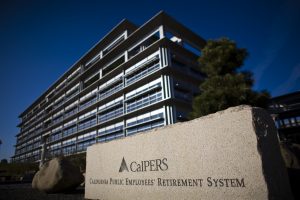
- PE nets 13.9 pct, almost doubling assumed rate of return
- CalPERS funded ratio improves to 68 pct
- PE program scrutinized in recent months amid fee, transparency disputes
California Public Employees’ Retirement System’s investment portfolio returned 11.2 percent in the 2016-2017 fiscal year, thanks in no small part to the 13.9 percent return delivered by its $25.9 billion private equity portfolio.
The PE program boosted the overall performance of the $323 billion retirement system’s investment portfolio during a period in which low interest rates kept fixed-income returns close to nil, according to preliminary performance figures the system released July 14.
Despite falling well short of its benchmark, PE generated 13.9 percent in the 2016-2017 fiscal year, roughly doubling the public pension’s 7 percent assumed rate of return. Meanwhile, CalPERS’s $58.9 billion fixed-income portfolio returned just 0.3 percent.
Fiscal-year returns will be finalized later this year, after private-market performance for the quarter ended June 30 can be calculated.
The retirement system attributed the bulk of its overall performance to its $152.2 billion global-equity program, which netted 19.7 percent during the previous fiscal year. Its real-assets program, which includes holdings in real estate and infrastructure, netted 7.4 percent.
“In a year where public asset classes are producing 19-plus (percent), producing a benchmark of 23 percent, the returns of our PE asset class, while strong … we’re looking over longer term,” CalPERS CIO Ted Eliopoulos said during a media call on July 14.
Preliminary returns indicate CalPERS’s total investment portfolio cleared its 7 percent assumed rate of return by 4.2 percentage points.
CalPERS’s funded ratio, which measures its ability to cover future liabilities, improves when its total investment portfolio outperforms the assumed rate of return. The funded ratio improved to 68 percent from 65 percent with this year’s preliminary performance figures.
Private equity firestorm
Despite private equity’s important role in keeping CalPERS above its assumed rate of return, recent scrutiny of its PE program led Eliopoulos to warn of a possible reduction in its targeted allocation to the asset class.
Eliopoulos called the long-term viability of the retirement system’s 8 percent allocation to PE into question at a public board meeting last month, where he said the “fish bowl of CalPERS may have reached a tipping point for us in private equity.”
Buyouts recently reported that CalPERS had omitted previously disclosed fees and expenses from its audited financial statements by claiming those costs were not investment-related.
Scrutiny of the PE portfolio, and the way in which the retirement system disclosed the fees and costs associated with its holdings, led to outside pressure from activists, board members and elected officials.
This pressure may force CalPERS to consider reducing its allocation to the asset class, Eliopoulos said in the June board meeting.
“If we want to continue to be a player, we need to give credit to the work we’ve done, and credit to the efforts of the investments team. He was looking ahead to our work in private equity going forward,” spokesman Wayne Davis told Buyouts in an email, expanding on Eliopoulos’s comments.
It’s unclear how the attribution of credit will affect CalPERS’s ability to access the asset class moving forward. Davis declined to provide additional context.
The retirement system will consider alternative approaches to the private equity investing, including more direct and co-investments, at its July 17-19 meeting.
Action Item: For more information on CalPERS, visit www.calpers.ca.gov


 If you do not receive this within five minutes, please try and sign in again. If the problem persists, please
email:
If you do not receive this within five minutes, please try and sign in again. If the problem persists, please
email: